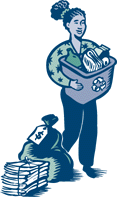Civic Groups
More Fact Sheets
Introduction | What is Pay-as-you-throw? | What are the benefits of Pay-as-you-throw? | Are there disadvantages to Pay-as-you-throw? | How can our organization help? | How can I learn more about Pay-as-you-throw?
Fact Sheet
EPA530-F-97-006
April 1997
Introduction
Pay-as-you-throw programs encourage people to save money by recycling and preventing waste. Imagine: a solid waste solution that's good for the wallet and helps the environment.
When it comes to managing solid waste, the goal for the past 10 years has been to reduce, reuse, and recycle. Today, thousands of community recycling programs collect for remanufacturing into useful products millions of tons of valuable materials that would otherwise be thrown away.
 Despite
the tremendous growth in recycling, however, waste-generation
rates among individuals continue to rise. Most of
us don't give as much thought as we should to reducing
the amount of waste that remains after recycling.
Despite
the tremendous growth in recycling, however, waste-generation
rates among individuals continue to rise. Most of
us don't give as much thought as we should to reducing
the amount of waste that remains after recycling.
One reason is that we usually have no incentive, beyond a general environmental concern, to reduce waste. Because individuals in most communities pay for collection and disposal services through property taxes (or, in some cases, through a flat fee), they pay the same amount no matter how much they throw away.
There is a different type of program, however, that communities can use to motivate residents not only to recycle more, but also to think of ways to prevent waste in the first place. They're called "pay-as-you-throw" (PAYT) programs, and nearly 6,000 communities across the country have begun using them.
What is Pay-as-you-throw?
PAYT programs, also known as unit-based or variable-rate pricing, provide direct economic incentives for people to reduce the amount of waste they generate. Households are charged for waste collection based on the amount of waste they throw away-in the same way they are charged for electricity, gas, and other utilities.
In some communities, PAYT is based on volume: residents are charged for each bag or can of waste they generate. A few communities bill residents based on the weight of their trash. Either way, these programs give everyone an extra push to prevent waste. They connect our environmental concerns with our wallets.
What are the benefits of Pay-as-you-throw?
PAYT programs have environmental and economic advantages and are often more equitable for residents-a combination of benefits called the "Three Es." Communities with programs in place have reported reductions in waste amounts ranging from 25 to 35 percent, on average. This results in several important environmental benefits. Less waste and greater recycling mean that fewer natural resources are used, less energy is consumed, and less pollution is created. In addition, landfill space is used at a slower rate, reducing the need to site additional facilities.
PAYT also can send an important source reduction signal to product manufacturers. When individual consumers begin to understand that their trash costs money, they are likely to adjust their purchasing habits to favor products that will result in less waste-and, therefore, cost less-when discarded. As more communities adopt these programs, manufacturers will have an incentive to redesign their products to appeal to this growing consumer preference.
There also are potential economic advantages, both for communities and their residents. Because they often have more recovered materials and less waste to dispose of, many communities with PAYT find their disposal costs go down. These programs also can yield savings in waste transportation expenses and potentially generate greater revenues from the sale of collected recyclables.
While they may not realize it, residents pay to throw away trash. Whether they pay through their taxes or with a flat fee, those who generate less and recycle more are paying for neighbors who generate two or three times as much waste. PAYT is more equitable: residents who reduce and recycle are rewarded with a lower trash bill.
Are there disadvantages to Pay-as-you-throw?
While there are potential barriers to a successful program, communities with PAYT have found effective solutions. Local officials, for example, often assume that illegal dumping will increase once residents are asked to pay for each container of waste they generate. Most PAYT communities have found this not to be the case, however, especially when they offer their residents recycling, composting for yard trimmings, and other programs that allow individuals to reduce waste legally. Others, particularly lower-income residents, worry about the amount they will have to pay. In many communities, however, coupon or voucher programs are helping to defray their expenses.
How can our organization help?
 In
many cases, local officials either are not aware
of PAYTor haven't considered how it might work in
their community. While they may not be appropriate
for all communities, municipal planners can benefit
from learning about these programs. Your organization
can work with local, regional, or state government
officials to make them aware of the benefits of
PAYT and how any potential barriers might be overcome.
In
many cases, local officials either are not aware
of PAYTor haven't considered how it might work in
their community. While they may not be appropriate
for all communities, municipal planners can benefit
from learning about these programs. Your organization
can work with local, regional, or state government
officials to make them aware of the benefits of
PAYT and how any potential barriers might be overcome.
Once communities in your area begin to plan PAYT programs, your organization also can assist in their development and implementation. By helping municipal officials plan programs that are reasonable and equitable, and by educating people about the benefits of the new system, your organization can play a role in improving the way we manage solid waste in this country.
How can I learn more about Pay-as-you-throw?
EPA has developed a series of products for anyone interested in PAYT. Individuals looking for more information on these programs can request additional fact sheets, community success stories, and other materials. For local solid waste planners interested in bringing PAYT to their communities, EPA has developed a comprehensive set of tools to help them design and implement a successful program. Visit the Publications section for more information.
![[logo] US EPA](../gif/logo_epaseal.gif)